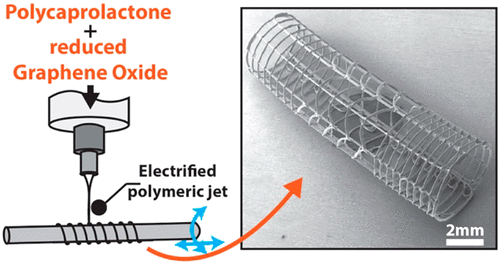当前位置:
X-MOL 学术
›
ACS Macro Lett.
›
论文详情
Our official English website, www.x-mol.net, welcomes your
feedback! (Note: you will need to create a separate account there.)
Personalized, Mechanically Strong, and Biodegradable Coronary Artery Stents via Melt Electrowriting
ACS Macro Letters ( IF 5.1 ) Pub Date : 2020-11-16 , DOI: 10.1021/acsmacrolett.0c00644 Katarzyna Somszor 1 , Onur Bas 2 , Fatemeh Karimi 3, 4 , Tara Shabab 2 , Navid T. Saidy 2, 5 , Andrea J. O’Connor 1 , Amanda V. Ellis 3 , Dietmar Hutmacher 2 , Daniel E. Heath 1
ACS Macro Letters ( IF 5.1 ) Pub Date : 2020-11-16 , DOI: 10.1021/acsmacrolett.0c00644 Katarzyna Somszor 1 , Onur Bas 2 , Fatemeh Karimi 3, 4 , Tara Shabab 2 , Navid T. Saidy 2, 5 , Andrea J. O’Connor 1 , Amanda V. Ellis 3 , Dietmar Hutmacher 2 , Daniel E. Heath 1
Affiliation

|
Biodegradable coronary artery stents are sought-after alternatives to permanent stents. These devices are designed to degrade after the blood vessel heals, leaving behind a regenerated artery. The original generation of clinically available biodegradable stents required significantly thicker struts (∼150 μm) than nondegradable ones to ensure sufficient mechanical strength. However, these thicker struts proved to be a key contributor to the clinical failure of the stents. A current challenge lies in the fabrication of stents that possess both thin struts and adequate mechanical strength. In this contribution, we describe a method for the bottom-up, additive manufacturing of biodegradable composite stents with ultrathin fibers and superior mechanical properties compared to the base polymer. Specifically, we illustrate that melt electrowriting (MEW) can be used to 3D print composite structures with thin struts (60–80 μm) and a high degree of geometric complexity required for stenting applications. Additionally, this technology allows additive manufacture of personalized stents that are customized to a patient’s unique anatomy and disease state. Furthermore, we illustrate that polycaprolactone-reduced graphene oxide nanocomposites have superior mechanical properties compared to original polycaprolactone without detriment to the material’s cytocompatibility and that customizable stent-like structures can be fabricated from these materials with struts as thin as 60 μm, well below the target value for clinical use of 80 μm.
中文翻译:

个性化,机械强度高且可生物降解的冠状动脉支架(通过融化电子书写)
生物可降解冠状动脉支架是永久性支架的替代品。这些设备旨在在血管愈合后降解,而留下再生的动脉。临床上可用的可生物降解支架的最初一代需要比不可降解的支架厚得多的支撑杆(约150μm),以确保足够的机械强度。然而,这些较粗的支柱被证明是支架临床失败的关键因素。当前的挑战在于制造既具有薄的支柱又具有足够的机械强度的支架。在这项贡献中,我们描述了一种自底向上,与基础聚合物相比具有超细纤维和优异机械性能的可生物降解复合材料支架的增材制造方法。特别,我们举例说明,熔融电写(MEW)可用于3D打印具有细支杆(60–80μm)和支架应用所需的高度几何复杂性的复合结构。此外,该技术还允许根据患者的独特解剖结构和疾病状态对个性化支架进行增材制造。此外,我们证明了聚己内酯还原的氧化石墨烯纳米复合材料与原始聚己内酯相比具有优异的机械性能,且不会损害该材料的细胞相容性,并且可以用这些材料制造出可定制的支架状结构,其撑杆厚度可薄至60μm,远低于目标临床使用值为80μm。
更新日期:2020-12-15
中文翻译:

个性化,机械强度高且可生物降解的冠状动脉支架(通过融化电子书写)
生物可降解冠状动脉支架是永久性支架的替代品。这些设备旨在在血管愈合后降解,而留下再生的动脉。临床上可用的可生物降解支架的最初一代需要比不可降解的支架厚得多的支撑杆(约150μm),以确保足够的机械强度。然而,这些较粗的支柱被证明是支架临床失败的关键因素。当前的挑战在于制造既具有薄的支柱又具有足够的机械强度的支架。在这项贡献中,我们描述了一种自底向上,与基础聚合物相比具有超细纤维和优异机械性能的可生物降解复合材料支架的增材制造方法。特别,我们举例说明,熔融电写(MEW)可用于3D打印具有细支杆(60–80μm)和支架应用所需的高度几何复杂性的复合结构。此外,该技术还允许根据患者的独特解剖结构和疾病状态对个性化支架进行增材制造。此外,我们证明了聚己内酯还原的氧化石墨烯纳米复合材料与原始聚己内酯相比具有优异的机械性能,且不会损害该材料的细胞相容性,并且可以用这些材料制造出可定制的支架状结构,其撑杆厚度可薄至60μm,远低于目标临床使用值为80μm。











































 京公网安备 11010802027423号
京公网安备 11010802027423号